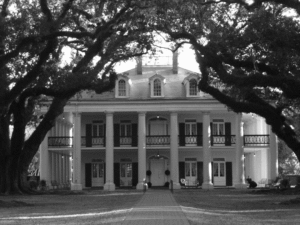Four growing seasons a year and 60 inches of rain
Posted on October 5, 2017 by Maple Creek
Dominique Liboiron
Rain makes or breaks producers. Whether they grow grain, grass or hay, farmers and ranchers depend on moisture. Unfortunately, precipitation isn’t reliable in Saskatchewan and the growing season is short. For curiosity’s sake, let’s explore a place that has four growing seasons a year and where sixty inches of rain is the norm.
Louisiana isn’t thought of as an agricultural paradise. Known for its bayous, alligators, spicy cuisine, voodoo and annual Mardi Gras, Louisiana also exports cotton, soybeans, cattle, rice and sugar cane. Blessed with rich soil, ample sunshine, heat and plenty of rain, the land of the Cajuns is the ideal location for agriculture to thrive.
Let’s visit one farm in particular except no one in Louisiana would call it a farm. The locals would use the term plantation. More specifically, we’ll visit Oak Alley Plantation with its Southern mansion that looks like a scene from Gone With the Wind.
Oak Alley gets its name from the twenty-eight oak trees that stretch from the front of white pillared mansion to the Mississippi River located an eighth of a mile away.
All evenly spaced, the massive centuries-old oaks create a shaded canopy to block the near-tropical sun. Thick moss covers the base of the trunks and overhead a tremendous number of small ferns emerge and thrive in the cracks in the bark thanks to the ever-present Southern humidity.
No one knows for sure who planted the oaks, but the popular belief is they were planted by a fur trader in the 1700s to serve as a landmark so the Natives could find his trading post.
What we know for sure is that when Jacques Roman saw the alleyway of oaks, he simply had to own the property and essentially bought it for the trees. The Roman family, Jacques and Célina and their children, lived there in the 1830s and ‘40s. They built the mansion and turned the property into a sugar cane plantation. The Romans were French-speaking upper class landowners who were at the pinnacle of Louisiana’s society. Because of their social standing, the Romans didn’t work the land themselves. They relied on slaves and owned dozens of them.
The slaves planted sugar cane by hand. To do this, they planted cuttings in the rich soil found in the floodplain along the Mississippi River. The cuttings contained at least one bud. Nourished by abundant rain and strong sun, the cane grew rapidly and could be harvested up to ten times before yields suffered and the crop needed to be replanted.
Like the planting, the harvest was done by hand, too. The slaves would set fire to the crop. This removed the leaves, but left the stalks and roots in tact and they contain the sugar. Another advantage is that fire scared away snakes such as the cottonmouth, a venomous predator which inhabits the South and is known for its aggression. Using machetes, the slaves hacked the sugar cane and hauled it away for processing.
Due to the collapse of the Southern economy, the Roman family lost the property after the Civil War. The home switched hands here and there until 1925 when Andrew Stewart made a present of it to his wife Josephine, who was from the Armstrong family known in ranching circles as the owners of the Armstrong Ranch near Austin, Texas. She restored the mansion to its former glory and devised a way to share her appreciation of it with the public in perpetuity.
She created a non-profit foundation and opened the mansion to public tours. The proceeds from the sugar cane crop help pay for the tour guides and the large house’s upkeep.
The plantation is set on 1,200 acres, which is considered sizeable in Louisiana because of the four growing seasons. In a way, a 1,200-acre plantation in the South is like a 4,800 acre farm in Saskatchewan because of our single growing season.
Another difference in Louisiana is that the farmland isn’t survey in squares, which is the usual British and American method in the West. Aerial photos of Louisiana show how the state was survey using the French system of river lots. Rather than dividing farmland into squares, river lots are long, narrow rectangles. Shaped like a football field with the narrow end touching the river, these skinny plots stretch inland. The reasoning behind this method is that all landowners have access to water, either for consumption or transportation.
Oak Alley remains a sugar cane plantation to this day, but the work is done mechanically now. Typically, the crop is replanted after two or three harvests to ensure yields remain high.
The mansion, slave quarters and fields are all open to the public for tours.
NEWS PHOTO DOMINIQUE LIBOIRON
Oak Alley gets its name from the twenty-eight oak trees that stretch from the front of white pillared mansion to the Mississippi River located an eighth of a mile away. The property has been a sugar cane plantation since before the US Civil War.



Leave a Reply
You must be logged in to post a comment.